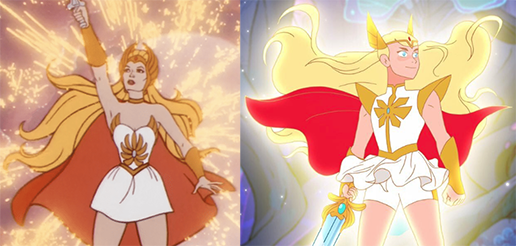During the COVID-19 pandemic, I was looking for media to watch when I had very little to do, and that was when I found the new She-Ra show on Netflix. I was interested, and after watching the whole show, I adored how many diverse characters were actively visible in the show. I then looked back at the original show and was shocked to find how different the characterization was. Now, with this assignment, I decided that these shows would be perfect to analyse, as they contrast each other a lot despite being the same characters from the same franchise.
The diverse character that I chose was She-Ra, also known as Adora. She-Ra’s initial appearance was in She-Ra: Princess of Power, a spin off show released in 1985, in the same universe of He-Man & the Masters of the Universe. Then, in 2018, the She-Ra franchise was rebooted when N.D. Stevenson created She-Ra and the Princesses of Power. The rebooted show was released as a Netflix original, and received great reviews. Some of the characteristics I am analysing include the physical appearance of She-Ra, She-Ra’s personality traits, and the relationships and friendships She-Ra has.
Firstly, how She-Ra is shown in both shows differs greatly. Within both the He-Man and She-Ra series from 1985, the characters look either hyper masculine or hyper feminine. In the case of She-Ra, she has an hourglass body type, with a large chest. This differs greatly from how She-Ra is shown in the 2018 series, as Adora is shown with a more neutral or even masculine appearance. Her chest is smaller and is much less noticeable in all outfits she wears, and she has shorts visible underneath her skirt in her She-Ra outfit. The show’s creator N.D. Stevenson has even said that the She-Ra costume Adora wears “is […] a specific femininity that [Adora’s] not comfortable with […] She Ra has always been a little bit of an uncomfortable costume for her.” The change in Adora’s body type in the newer show is important, as it shows a more realistic body type rather than the former hyper feminine body, which helps break previous ideas surrounding what is considered ideal for a female body.
Adora’s attitude and personality also changes in between the two shows. She is shown to be strong, brave, sympathetic, and a leader in both shows. However, the 2018 reboot also highlights some of her flaws. She has been shown to be clumsy and stressed, and is also constantly thinking that she needs to fix anything that is broken. By showing that she is a hero with these flaws and problems makes her seem like a more realistic and fleshed out character.
Next, we see the characters Adora surrounds herself with in both shows, and they starkly contrast each other. In the 1985 show, She-Ra is shown as He-Man’s twin sister who was kidnapped at birth. However, she appears more as a female version of He-Man than as his twin, and He-Man still plays a strong part in her show. However, in the 2018 reboot, there are no mentions of He-Man at all, and She-Ra’s backstory is changed to remove the origin story from 1985. Adora’s friends also change too; her friends end up having more diverse designs and personalities than what they previously were in 1985. Adora’s friends help in “[increasing] representation by including queer relationships […], different body types, and more characters of colour […] .” This differs greatly from how many characters were of the same race, body type, and sexuality in the original show.
The biggest change in her relationships comes in the form of her love interests. In the original 1985 show, she eventually falls in love with a pirate named Sea Hawk. While her love life does not seem to be the biggest focus in the show, it is assumed that she is straight and a heteronormative character. However, in the 2018 reboot, this is starkly changed. Throughout the course of the show, we see the relationship between Adora and Catra, her former best friend turned nemesis. Throughout the series, “queer representation was not as explicit [but] it became more prevalent”, and we started to see how Catra has developed feelings towards Adora. Then, in the final episodes of She-Ra, when tensions are at their highest, Catra confesses her love for Adora. Adora returns these feelings, and they share a kiss. This inclusion of two main characters both being lesbians and sharing a kiss on screen was very important, as this would have been unheard of in television shows previously. It also shows a very positive message towards LGBTQ+ themes, which has become increasingly more important to show in today’s media.
Overall, She-Ra has become a more diverse character than how she was originally imagined in the 1985 series. She has a realistic body type, a more realistic personality, a diverse set of friends, and she is eventually shown to be in a lesbian relationship. Because of the reboot, She-Ra has now become an entirely new character for future generations to see, and her characterization shows how cultural ideas have shifted in the past 40 years.
Bibliography
Austin, Sara. “Reimagining the Past to Construct the Future: Nostalgia and Netflix’s She-Ra.”
Adaptation 16, no. 3 (2023): 281-293. https://doi.org/10.1093/adaptation/apad018
Burgos, Diana. “The Queer Glow up of Hero-Sword Legacies in She-Ra, Korra, and Sailor
Moon” Open Cultural Studies 5, no. 1 (2021): 248-261. https://doi.org/10.1515/culture-2020-0135
Cummings, Kelsey. “Queer Seriality, Streaming Television, and She-Ra and the Princesses of
Power.” Global Storytelling: Journal of Digital and Moving Images 2, no. 1 (2022): 39-55. https://doi.org/10.3998/gs.1547
Stevenson, Nate D, dir. She-Ra and the Princesses of Power, 2018; Netflix.
https://www.netflix.com/title/80179762
Wetzler, Gwen, dir. She-Ra: Princess of Power. 1985. Los Angeles: Filmation. In broadcast syndication.


Emilia Caiza
In the post “She-Ra had a huge gay glow up since 1985” by Brook Harrington, the physical appearance, personality and relationships of the 1985 and 2018 version of She-Ra are compared and analyzed. In the 1985 series She-Ra is presented with a large chest and hourglass body and the 2018 version shows a neutral appearance and a more realistic body type that breaks the stablish ideal of the female body, as for the personalities, Harrington mentions that both versions share brave, sympathetic, and strong personalities, but the 2018 series show and highlight the flaws of the character which leads to a much realistic hero. During the analysis, the biggest difference between the two versions is how her relationships are shown. In the 1985 version, She-Ra is the twin sister of He-Man, who plays a big role in her story, but in the 2018 reboot, this was scratch off as she is given a new back story and friends who also have a divers set of characteristics, sexualities and body types. In the new remake, She-Ra is shown as a lesbian who at the end of the show shares a kiss with Catra which shows two LGBTQ+ main characters and not a assumes that She-Ra is a straight and heteronormative character as the 1985 version did.
The sources use in this analysis are highly relevant on the topic as they center or have a specific focus on She-Ra and the changes made to the character. Still, some points such as the difference between the personalities of both characters could have been analyzed in more depth. Also, It could have been interesting to focus a little more in the change of clothing as this shows a big difference between the hyper sexualization of the character and how this was change with the multiple outfits that She-Ra wears in the remake.
-Emilia Caiza